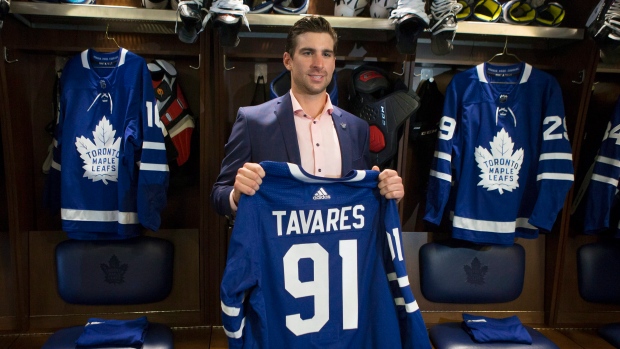Aug 7, 2018
Signing bonus issue lingers over next NHL labour deal
Players valuing signing bonus money as part of their contracts can put some of the league’s small-market teams in a bit of a bind, Travis Yost writes.
By Travis Yost

To land superstar centre John Tavares, the Toronto Maple Leafs exercised their financial might and structured a contract most teams around the league couldn’t possibly fathom.
On the surface, Tavares’ contract isn’t that exotic. A seven-year, $77 million contract for one of the league’s preeminent scorers was expected. In fact, TSN Hockey Insider Darren Dreger reported that Tavares “left millions on the table” by signing with Toronto.
There are probably a multitude of reasons Tavares chose the Maple Leafs, but one item on that list is the actual structuring of his contract. Tavares’ contract is laced with signing bonus money, which has become a very popular stipulation for players under the latest collective bargaining agreement.
Almost $71 million – or 92 per cent of Tavares’ contract – will come by way of signing bonus, which offers myriad benefits to the player. Chiefly: he will pay at a substantially lower tax rate and his contract effectively becomes buyout proof. Under the current CBA, buyouts are calculated by taking two-thirds of remaining salaries, exclusive of signing bonuses, then spread over twice the remaining contract length. Thus, signing bonuses effectively take buyouts off the table, since the teams don’t enjoy any real cap relief. It all but guarantees a player will be paid for what his contract was actually signed for and not a stipulated lesser amount. They’ve also become fabled lockout protection. Signing bonuses, unlike straight salary, must be paid if the league decides to shut its doors.
The structure of Tavares’ deal may be on the extreme side, but he’s certainly not the only player to earn a lot of his pay by way of signing bonuses. Oilers superstar Connor McDavid will earn $86 million of his next contract in a similar manner. Lightning centre Steven Stamkos was the predecessor of that deal, having $60 million in signing bonus money embedded in his contract. Before Stamkos we saw Patrick Kane and Jonathan Toews ink contracts with $44 million a piece in signing bonus money. Point being: If you’re a star in this league, you are generally getting sizable cheques sent your way on July 1.
As a brief aside, the NHL isn’t far away from another “lockout watch” – owners can officially opt out of the current CBA on Sept. 1, 2019. There have been myriad complaints about the structuring of escrow, among others. I believe signing bonuses are a major issue, and reports indicate that the league has either informally or formally pled with teams to stop handing them out.
Still, the power teams don’t seem to be listening. It’s hard to blame them, since procuring and preserving talent in any major sports league is a challenge in and of itself. But it has created an interesting “have” versus “have not” dichotomy – one that still highlights spending disparities in a league that prides itself in a hard cap structure and intensive revenue sharing program.
The league has been increasingly aware and vocal about the signing bonus issue over the last couple of seasons. Look at the spread of team payouts by way of signing bonuses over just the last two seasons, and note how little it’s changed even when compared to prior periods:
Signing bonus money works against the hard cap the same way an ordinary contract does, but I don’t think the league envisioned two things here. One, signing bonuses have put substantially more leverage in the hands of the players, which the league is never going to be particularly happy with. Two, it’s created a massive delta between revenue sharing and non-revenue-sharing teams.
Think about it from this perspective: The average team from 2015-17 spent about $8.4 million against the salary cap by way of signing bonuses. That grew to $13.8 million (or, a growth of 63 per cent) in 2017-19. And because that’s grown, so too has the standard deviation between the samples – about 37 per cent over the same period.
This is how you end up in situations where the Maple Leafs can spend $42 million in signing bonus money from 2017-19 while their provincial rival, the Ottawa Senators, spend $4 million. You can also point to the Washington Capitals and their $39 million in signing bonuses versus division rivals Carolina and Columbus, who have spent about $500,000 each.
Now, some of this is a matter or circumstance. Teams that are contenders are going to be more willing to get aggressive with signing bonuses. Teams with no obvious plan to reach the postseason are always going to be more conservative, dumping contracts and generally keeping salaries low. So there will always be a natural split in payouts, whether we are talking signing bonuses or team salary in general.
But Carolina, Columbus, and Ottawa – just to name a few teams here – have been contenders in past years and had rosters equipped for the postseason. And yet, they have historically spent very little by way of signing bonus money. If the players truly value it as part of their contracts, it can put some of the small-market teams (who may be cash strapped to begin with) in a bit of a bind.
It’s an interesting issue to keep an eye on as the NHL and NHLPA gear up for the next round of CBA negotiations.
(Cap data compiled via Spotrac and CapFriendly)

